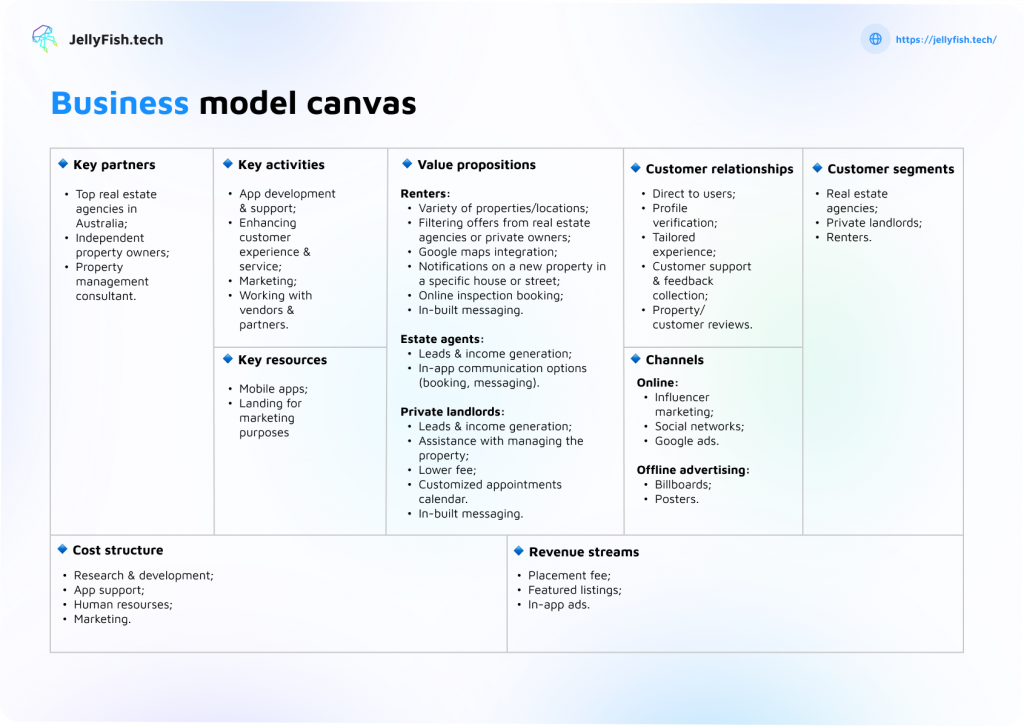Basics of marketing your minimum viable product
A minimum viable product (MVP) is the first version of your app containing only the core features to solve a big problem your customers have.
MVP is used for attracting investments and getting accurate feedback from a target audience to understand if a business idea works.
Although your MVP isn’t a 100% mature product, you still need to think about how you will market it and create a high-level strategy at the very beginning.
“But I’m not a marketer!” — you’ll probably think. The point is nobody knows your business strategy better than you, so it’s possible to turn your product knowledge into a marketing strategy without hiring a specialist (but you’ll probably need someone to execute the strategy later on).
Contents:
How to craft a marketing strategy for your MVP?
Of course, each case needs a marketing approach tailored to the specific audience and the product you’re going to offer.
However, the pandemic demands us to move online, so your minimum viable product will most likely be marketed using digital channels.
That is why this article will be entirely devoted to the key stages of building a digital marketing strategy for an MVP.
Okay, let’s go.
Analyze the background ✍️
Goal: fill in business/lean canvas.
Checking the background is a starting point for any strategy.
Here, you need to summarize all the data you have about:
- your product;
- potential customers;
- the market you are targeted at.
This is where the business model/lean canvas comes into play and allows you to capture the business model on one page. Unlike a bulky business plan, this canvas template can be filled in about 30 minutes and quickly adjusted as the project evolves or market conditions change.
Here is an example of a well-structured business model canvas:

Analyze your customers 🕵️♀️
Goal: create customer personas.
A customer persona is an abstract ideal representation of your target audience.
Understanding your customers is crucial when delivering a solution for them. Learning their routine, pain points, the way they choose a product and shop helps you meet their demand.

Don’t forget that you’ll still be doing customer personas to validate your business idea, so make sure you have the marketing questions added to customer development interviews!
1. Define which information is must-know to fill in the “customer profile” and prepare the list of questions.
For example, we need to know how prospects could discover our solution on the web.
The typical questions here could be:
- “How do you get updated about the latest news in *your sphere*?”
- “What are the top online platforms/forums/professional networks you check regularly?”
- “What does the process of choosing a solution look like?”
- “Are there any influencers in the *sphere* you follow?”
- “What job-related content would you like to get?”
- “Are there any blank spaces in *your sphere* you want to be covered”?
- “Which online events in *your sphere* do you attend/would like to attend?”
- “Which types of content do you prefer: infographics, video, images, graphs, articles…”
- “What do you like/dislike the most about the job-related content you consume?”
Of course, the list of your questions could be adjusted to the type of product you offer and the industry. The essential is to dive into the research and be where your customers are to create certain hypotheses and verify them during the next step.
2. Go and ask your target audience directly.
Surveys and interviews are everything for a founder. Using them, you can directly reach out to your prospects and collect valuable information firsthand (and do a little pre-sale as well:).
Currently, online surveys are a top pick method since they can be held in any form that is convenient for both prospect and founder:
- Face-to-face meetings (or online video call) is a good option if you want to see a person’s non-verbal reactions as well;
- Phone interviews;
- Google forms;
- E-mails or messengers;
- Statistics posts on social networks.
Why do you need to get all this job done?
Clearly defined customer personas give you multiple perks, allowing you to:
- Align your product vision and customer demand with marketing & sales strategies.
- Polish your unique value proposition and as a result marketing campaign for every customer type.
- Base your marketing strategy on data, not only your hypotheses.
- Focus your efforts on solving a specific pain point of a specific person instead of “selling everything to everyone”;
That’s why I recommend that you start crafting a customer persona doc asap and get back to it regularly to make sure it stays up-to-date.
Analyze your competitors 🔎
Goal: create a customer analysis report.
Competitor analysis is the next step to crafting a killer marketing strategy.
It’s the easiest way to find out:
- Overall market trends & tendencies;
- Main performance indicators to define KPIs for your marketing plan;
- Tricks your competitors’ use and the best practices they follow;
- Competitor’s weaknesses and blind spots to cover.
Here, you have two options: you can either do everything manually or use special tools.
In the first case, use the google/bing search (depends on what your customers use more often) to find the competitors and put the result in google sheets or a template for the competitor’s analysis. The analysis criteria may vary depending on your industry. However, in general, they may include the following:
- company name;
- motto and brand logo;
- foundation date;
- company size and location;
- target customers;
- web presence (including social media);
- pricing strategy;
- top product features.
Once the doc is ready, try to find the common patterns (for example, more than half of the competitors manage large Facebook communities) and gaps (for example, none of the competitors use an environment-friendly approach).
If you want to save time, you should try one of the paid tools for competitor analysis. Below, I’ve listed some examples of tools I use for Jellyfish.tech marketing.
| All-in-one SEO tools | Can-dos |
| Ahrefs Serpstat Semrush | – Discover the website structure. – See the number of website visitors, their demographics. – Check the top pages and discover new content topics. – Understand which keywords they use. – See who gave a backlink to your competitors. – Check their web “authority”. – Track their ranking, getting an update when something changes. |
Using one of the SEO tools, you could deeply analyze your competitors and their strategy to take only the best for your marketing. Besides, all the tools offer a smooth onboarding and a powerful knowledge base so that you could quickly learn to perform the basic tasks.
P.S. It will be enough for you to check the competitors and track your own ranking further.
Shape your digital marketing strategy 🎯
Goal: document a high-level marketing strategy.
Now you could start putting your previously discovered data on a marketing board. Start small: make a high-level draft of a marketing funnel from awareness to purchase where you list the channels your customers use and the types of content you may offer.
| Awareness | Consideration | Decision | |
| Typical questions | How could I do it better? Can I automate this process? How do my peers deal with it? | What are the alternatives? Which features will I use? Is it hard to switch to the solution? | Is your solution really a fit? |
| Emotions | Tired of the routine, curious, proactive, enthusiastic to find a solution. | Uncertain, confused, attentive to detail, trying to find a good value for money. | Excited. |
| Main channels | Word-of-mouth, web search, niche forums, Q&A platforms, industry influencers. | Your competitors’ content, review platforms, Q&A forums, product support teams. | Sales representatives. |
| Content | Blog posts, videos, social media posts, influencers ads, paid ads. | Blog posts, newsletters, webinars, solutions comparisons, videos. | Demo, sales presentations. |
Then, break your strategy down to specific and measurable steps or tasks, creating a marketing backlog.
Usually, you’ll have a few areas to focus on here:
| Focus area | What it’s all about |
| Content plan | It’s not a secret that content marketing is now considered one of the best (and relatively cheapest) ways to tell a brand story. Don’t be afraid to share your expertise in blogs and tell your prospects how they could make the most of your product. You could use the above-mentioned SEO tools to find the relevant keywords, and ask your customers directly which topics they’re interested in. |
| Social media plan | The dream of every company owner is to form a community around their brand. And social networks are the right instrument to do it. As it’s always exciting to watch the startups grow, overcome challenges, and scale, feel invited to post product updates, startup owner insights, success/failure stories. Communicate with other startups, share your experience, and don’t be afraid to ask for advice. |
| Newsletter | Start growing your subscriber base from the very beginning. Ask people whom you interviewed to join your mailing list. Add the “Subscribe” button to your website (if you have any) or directly to your app. Keep your subscribers updated about what’s happening with your startup, and notify them when MVP is released. |
| Content distribution (+ link building) | This activity will help you both enhance your online presence, attracting traffic to your product, and improve your SEO metrics. Make a list of the platforms where you could spread the word about your product (review platforms, listings, directories, Q&A, forums, industry-related media, etc.) to add the link to your MVP there once it’s ready. |
| Paid ads | Yes, paid advertising can be quite expensive for a startup (for us, it’s still expensive btw). However, it can also become a perfect instrument to check the market demand and understand how many paid customers you could have even before spending money on MVP. Even after an MVP launch, it could become the right tool to use in your specific situation. |
| Industry events | Online conferences, webinars, masterclasses are a good place to stay updated about the industry, find new leads, share your expertise, network, and get product feedback. Start from defining the top events in your industry and see how you could participate. |
At this stage, you’d also pay attention to picking up the right tool, which makes it easy to create and adjust a strategy and doesn’t consume time. That is the reason why I’ve prepared a brief overview of the best tools for shaping a marketing strategy.
Trello. This is an excellent solution for effective communication between the members of your team during building a marketing strategy. The whole process is displayed on the board.
Even if you don’t have a team as of yet, it’s still easy to add/edit/delete the tasks shaping the marketing backlog and track the progress.
Jira. The task tracker, similar to Jira, is a complex solution for those who have some experience in project management. Hundreds of highly customizable options allow you to set up the marketing project with great precision.
Evernote. This tool also has a separate and fully-customizable template to work on your marketing strategy. It can help set up goals, identify marketing tactics, and keep your team members in sync.
Every tool also supports uploading documents, pictures, videos, PDF files to store all the necessary information in one place.
Kindly reminder. Your strategy shouldn’t cover everything, this is just a good starting point for your brand that can be pivoted, adjusted, or scaled at any moment based on the results you get and market demand. Your high-level marketing plan may be part of the discovery you do for MVP creation. Don’t try to do everything perfectly in one move, it won’t work out (I’ve learned this from my own experience:). The main goal here is to understand how marketing works in general and in your niche. The essential is to obtain and develop a vision of where to move further.
Why marketing is important
I often encounter an outlook: “A great product will market itself”.
I wish it was true! But the reality is the market of digital products and services is overwhelmed, so it’s not enough to deliver a good product. You should also understand for whom you build a product, which problem you solve, and how your customers could learn about your solution.
It means that the main task of today’s marketing is to help the “right” people discover how awesome your product is. Not annoy them with a bunch of emails, messages, and calls, but balance technical implementation, business strategy, sales, & marketing. Believe me, it’s worth thinking through all the details and strategies before investing in MVP creation. As I’ve faced cases when our customers had a well-designed MVP but didn’t know what to do next having no marketing strategy. As a result, they simply wasted the money without knowing how to launch a product.
Luckily, now we not only encourage everyone to think about marketing strategy in advance but also offer marketing assistance to all our customers. It’s important for us to make sure they not only get a scalable MVP/product but also have an understanding of what to do next.




